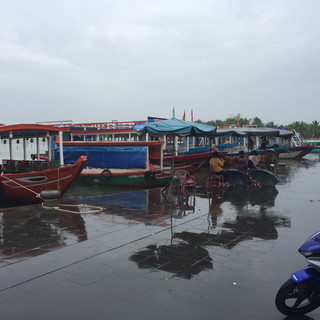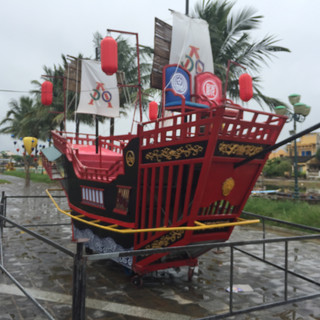Hội An's Colonial History
- Daniele Iannarone
- Nov 2, 2017
- 5 min read

Hoi An. No city epitomizes the heart of Vietnam more than this quaint town in the centre of the country. Far from the hustle of Hanoi, this city invites travellers to live a rather... different experience.
Hoi An is famous for its delicious cuisine, sense of style, and, above all, its extremely intriguing and diverse colonial history. The French colonial architecture radiates throughout this city, though the backstory is a lot more complex than what it may seem.
For years Vietnam had been a country that was constantly facing, warding off and resisting invasion. The country was occupied by the Chinese on several occasions, it fell victim to the French during the colonial period, which left quite a lasting impression on the country, and it was most famously the site of the Vietnam War, yet another territory disputed over by those meddling Americans and Russians. Hoi An is a city oozing with all of this history, and then some.
Hoi An, however, was not settled by any of the aforementioned nations, but rather by the Portuguese, who sailed South from the nearby city of Da Nang in 1535 and tried to establish a major trading centre in what was, at the time, a small village. The Portuguese were not there to stay, but Hoi An's success as a trading centre certainly was, as it remained one of the premier trading posts in all of Asia for nearly 400 years, from the 15th to the 19th century. Hoi An's demise, however, came after some internal conflicts within Vietnam caused neighbouring Da Nang to gain more prominence, to the point that when the French settled they were granted exclusive rights to operate out of Hoi An's neighbouring city, at which point Hoi An remained nearly forgotten and untouched for the longest time.

As you can see on the map, the cities of Hoi An and Da Nang are exceptionally close, and the Da Nang airport is actually what serves both cities.
Due to the unfortunate fate that befell the city a few hundred years ago, Hoi An today is one of the most spectacular places to visit in Vietnam. All of the blogs about Vietnam recommended the same thing, and the visit was well-worth it.
The first thing you notice about the city is the obvious: the extremely well-preserved French colonial architecture.
Now, don't get me wrong, by no means does Hoi An look French, nor does it feel French, however the French and European architecture can be seen throughout the entire city. If you look at some of the pictures above, for example, you can perceive some European-style balconies. The general shape of the buildings also resemble what you may be able to find in some European countries.
The true charm of this quaint town, however, is that the architecture is not solely European, but rather a nice blend of multiple cultures. Though the houses might resemble old European buildings, the surroundings definitely do not. My favourite part of the city was actually the river, where, on one side you see many houses, and on the other side a peaceful river dotted with various picturesque boats that add some beautiful colour contrasts to an already colourful city.
Sure, the boats are just boats, but they look particularly pretty against the backdrop. In fact, the panoramic views from the river perfectly showed the picturesque contrasts.

The colonial architecture you can find in Hoi An, however, is not solely limited to Europe. Perhaps the most famous tourist attraction in the city is the "Japanese Covered Bridge," which is essentially a bridge near the centre of the city crossing over a small river. I overheard a tour guide telling a French tour group some history about the bridge, and it turns out that it was erected as a sign of peace between the Chinese, the Japanese and the Vietnamese, seeing as the three of them had been doing business together in Vietnam.
Of course, being in the heart of Southeast Asia, Hoi An did feature its fair share of temples and local architecture.
Hoi An is actually quite a small city, so visiting all of these attractions and learning a bit about the history is not all that time-consuming. For some strange reason, and probably due to the city's unique history, two of the most popular things to do for tourists visiting the city is to get a suit tailored and to take a cooking class.
Now, I did neither. I had no real use for a suit, nor the budget for one, nor the capability to transport it all the way back to Seoul (and eventually back to Montreal) with me, so I decided to forgo that opportunity. I did, however, meet an awesome couple from New Zealand who were unable to resist the urge of getting one tailored for themselves, and as I bumped into them later that afternoon they happily shared their story. Interesting fact: they're actually moving to Canada, to Vancouver, in a few months!
Regarding the cooking class, well, due to time constraints I couldn't do that either. I was only in Hoi An for one day, seeing as I wanted to devote an ample amount of time to Hanoi, Halong Bay and Perfume Pagoda. This said, I did indeed discover Hoi An's culinary side; the city, much like the country, is a foodie paradise.
Smack in the centre of Hoi An, you can find an enormous food market, in which you can encounter anything your heart desires, may it be meat, seafood, fruit, vegetables, you name it.
The market itself was exhilerating and quite picturesque, a must-visit for anyone who just likes strolling around a traditional food market.
The market was my absolute favourite spot to visit, and over the course of the day I indulged in a grand total of SIX meals, four of them at the market. Needless to say it was probably one of the best food days of my entire life.
Everything was absolutely delicious. Two of the dishes actually originated from Hoi An, and I actually ate at the original Banh Mi sandwich restaurant while there, called Madam Kanh, the Banh Mi Queen. You can learn about all these dishes in depth as well as my full Vietnamese culinary experience HERE.
Finally, at night, the city grows even calmer, but it's even more stunning, as the lantern festival illuminates the already-picturesque streets.

For me, it was the perfect way to end my incredible stay in Vietnam; strolling along the tranquil, lantern-illuminated streets and savouring some cau lau with my new friends from the hostel. I was only there 24 hours, but boy was it worth it!
-Daniele






































































Comments